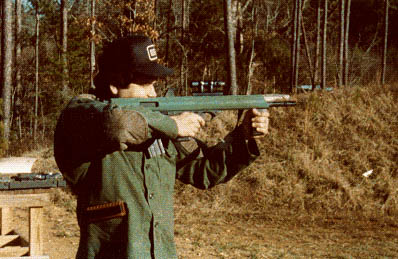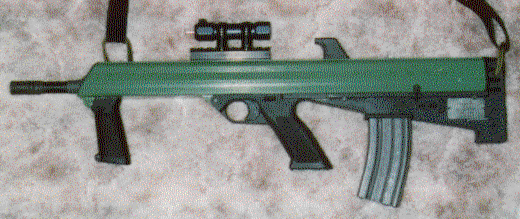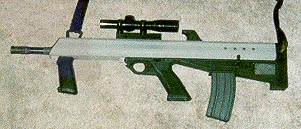
I have always had a lust for bullpup rifles. The first one I ever saw was the 7mm Enfield EM2, hidden deep in one of those crappy, superficial "History of Weapons" books that only a public library would buy.
Back in `89 I was saving up for a Steyr AUG, which at the time was selling for around $750. And then Patrick Purdy provided career scumbags like George Bush the political cover needed to place a ban on imported fun guns.
Suddenly my dream toy jumped to $3,000. Shit, I coulda kicked myself when I pondered all of the chances I had blown over the years to get one of the few other bullpups on the market, like the Valmet M82 or even the tiny Norinco (shortly before they went bye-bye, I saw one at an Ohio Gun Collector's show for $400!).
I thought that I was screwed. Fortunately, after several years capitalism intervened, and I grabbed a pre-Clinton ban Bushmaster/Quality Parts M17S Bullpup.

The gun has an AR-18 action, where a piston mounted onto the barrel jets gas into a cup, driving back an attached spring-loaded rod. This in turn smacks a massive steel bolt carrier, which moves backwards to unlock the M16-style rotating bolt and allow the spring-loaded ejector to throw the fired case out of the right-hand ejection port (unlike the French FA-MAS, there is no provision for a left-hand-friendly port swap). The recoil springs then return the bolt and carrier to battery, during which time the next round is stripped from the magazine. This system has been used on a number of weapons, with varying degrees of success.
Unfortunately, my M17S had a serial number below 500, and was only a few steps up from a toolroom prototype. Not unexpectedly, some problems cropped up.
(Weasel Words: As I mentioned before, my bullpup is a pre-ban model. Attempting to perform some of these alterations on a post-Ban rifle will probably win you a date with the BATF.)
A relatively light 1/4" push on the rear detent (or emptying a few magazines in rapid fire) would unlock it, permitting the upper and lower to separate slightly.
On a normal gun this would have been merely a nuisance, but the M17S utilizes a long transfer bar to connect the trigger to the trip for the rear-mounted hammer group -- which was thus being yanked upwards. Placing the butt firmly into the shoulder and pulling the trigger while this situation existed sometimes yielded an uncontrollable foray into full-auto fire sequence.
The machine-gun impersonation went away after I placed a frantic call to Bushmaster. They drilled out the detents and put in two more heavy pins. Later, they replaced the whole lower with a new one with full-size captive push-pin takedown similar to that on their AR-15s. If you are thinking of buying an M17S, be sure that you get this feature.
The carry handle/scope mount can easily be flexed 10 degrees up or down, and only two thin flanges prevent it from moving laterally. This cannot be good for accuracy.
Polymer is great for magazines and stocks (I have a baby Glock in my back pocket as I type this), but as the saps from RamLine proved years ago, it sucks as a reliable scope mount system.

I popped off the whole mess and replaced it with an aluminum AR-15 scope base that I picked up at a gun show for $8. After aligning it with the existing holes in the upper receiver, I carefully drilled two additional matching holes in the mount and secured it with two 10-32 screws from above (after turning their heads down a bit so that they would fit into the sight channel), and supplemented them with the supplied bolt from below. Believe me, the new base will not budge.
This rig is a heck of a lot shorter than the original combo, which meant that a scope on standard rings would be partially obscured by the cocking handle. I dug out my copy of the Natchez Shooter's Supply catalog and ordered a set of Burris extra-high steel Zee rings (if you are still chewing up bases with cheap aluminum rings, give these a shot).
Now that I had a tough mount, I wanted a sight that could stand up to the same amount of abuse. I long ago gave up on commercial scopes for anything but hunting guns, but did not have the big bucks laying around that mil-spec optics demand. So I bought another Armson OEG (marketed by Trijicon in the US of A) for $160.The OEG is a South African battle-tested red-dot sight that does not use batteries. It relies upon ambient light in the daytime and contains a tritium insert for night use. The acronym stands for Occluded Eye Gunsight, which means that one eye sees only a red dot against a black background, which your brain superimposes on the image from the other eye.
While not a target-quality sight by any means (at best I can get just over 4-inch groups from a bench), it is incredibly quick -- pulling the trigger the instant you acquire the target provides impressive results. And you can skip it across pavement without changing the point of impact.
I like this setup so much that I am thinking about expanding on it a bit. As shown in Figure Four, the current mount is only about four and a half inches long. Since the OEG is not see-thru, I am tempted to go to a longer mount so that I can place a flashlight directly in front of it on another set of shorter rings. An on/off pressure switch could then be placed on the front pistol grip.
It is mounted on an incline, which means that only the top flange takes stress when the barrel is tightened (the proper way to do this on the pre-ban model is to stick on the lock-nut first and snug it up, then slip on the lock washer, and then torque down the flash-hider while securing the lock-nut in order to prevent it from tightening further), and it also has to deal with the upward firing forces. Mine bit the big one after about a thousand rounds. I got a free replacement (and it seems to be made of stronger stuff), but yeeesh! The top flange should be at least twice as wide and as thick as possible.
The upper got a coat of olive drab high-temp auto paint and a trip to the oven to bake it on. Luckily I did this on a warm day so that I could open my windows and let the resulting stink out.

I then shaved down an
AR-15 pistol grip to fit it closer to flush, drilled the upper receiver just
behind the sling swivel base, and attached the grip with a long nut (the kind
used to attach two rods) which I notched deeply to accept a slotted screwdriver.
Now that I no longer have to touch metal, I can shoot the thing until it starts
glowing red.
Running parachute cord through the
front two top cooling holes on the upper receiver provided a place to sew on a
nylon sling. Applying my drill to the top sidewise portion of the buttstock permitted more
cord to be threaded through to form a loop (and the knot fits neatly into one
of the stock's waffle-pattern holes), to which I attached the other end of the
sling with an adjustable buckle.
I called the factory
and inquired about getting a new barrel. There were two choices: a original
pre-ban barrel that could accept a flash hider, or a chrome-lined post-ban
barrel that was only threaded long enough to accept two lock nuts and a
lock washer.
I decided
to create a third option, and enlisted a gunsmith pal of mine to chop down
the post-ban barrel (which Bushmaster sold me for half price to make up for
my original's problems) past the existing threads, turn it down to accept a
1/2" by 28 die, and rethread it to the original configuration. He even
threw in an accuracy-crown job for a grand total of $45. I'm leery of telling
you how accurate the new barrel turned out to be. You probably wouldn't believe
me.
I really wanted the
barrel shortened so that the flash hider was flush with the end cap, thereby
eliminating the need for the barrel extension, but this would have meant going
down to about 18.5", which may have created two problems.
First, that length would
have put me close to Randy Weaver territory on the federal overall minimum rifle
length requirement of 26" (the flash hider, which adds another inch,
does not count unless it is permanently attached). I figure that it is better
to be safe than butchered in bed by federal employees.
Second, my friend brought up the very real
possibility of reliability problems. Since the action depends on a strong
burst of gas while the bullet is still in the rifling, cutting down the
barrel means that there is less time for a sufficient impulse to be generated.
As a result,
I decided to go from the original 22" down to 20", which is fine
since this compromise will yield the same velocity and trajectory as all my
other .223 rifles.
Headspacing works the same as on an AR-15.
If a standard check gauge does not fit properly, try another bolt assembly.
Surprisingly, yanking the
barrel out for periodic maintenance of the gas system barely shifts the point
of impact. A scope would probably benefit from a slight readjustment, but I
don't even bother with the OEG.
The shorty layout means that the muzzle is almost a foot closer to the
shooter's face than normal
The resulting flash
signature is a tad troubling at night.
I have heard so much about the Vortex flash hiders that I decided try one out.
Luckily I managed to blow this purchase off until late last year, when it appears
that the company's patent ran out, because they are now available for about half
of their traditional $35-45 price.
The latest versions resemble the older ones, but the four projecting tines
now have a noticeable rake to the right, which is supposed to ensure that the
device tightens itself with every shot. It seems to work as well as advertised,
although I have not had the chance to try it out in full darkness yet. I'll
pencil it in for when the neighbors go away for a weekend.
The only pisser is that the manufacturer included
a list of recommended ammo along with the instructions. Guess what: "Canadian
SS-109 with head stamp dates of `85 and `86 should not be used."
Dedicated gun fags may remember that a few years
back this stuff was going for peanuts, still packed in the original steel cans,
on stripper clips, and in bandoliers. I have been sitting on top of a couple of
cases, all fat and sassy-like, figuring that I made the deal of the century.
Now I am assuming that it
was dumped on the market because it failed to meet the NATO flash specification,
if there is such a thing.
I placed a thin
washer alongside the trigger body to eliminate some sideways slop, and went lightly over
it with some crocus cloth glued onto a flat chunk of wood to take out any high spots.
The hammer group will get the spring kit treatment. I can't think of anything to do
to the trigger transfer bar, which looks like a piece of heat-treated coat hanger wire
with a small bend on either end to actually hook the trigger to the sear. This bugger
scares me, because it is only held in place by the upper receiver -- pulling the
trigger when the gun is field-stripped makes the bar pop out of its little track.
I doubt that this
rifle would pass the "mud puddle" test.
It's possible to funnel a round forward past the barrel extension
I've done it three times now. I don't cherish the thought of having a live
round rattling around by the reciprocating gas system parts. At the very least
this threatens a jam that would be a bitch to clear in a hurry. Giving the gun a
couple of good shakes with the muzzle pointed at the ground will usually permit
the cartridge to drop out of one of the end cap's cooling holes -- and is thus
the best argument for keeping 'em.
The gun tends to balk when fed via GI 30-round mags
A big drawback to the design is that there are two small recoil springs
driving a huge bolt carrier as opposed to a giant spring pushing a smaller
carrier as on the M16, so it is much more prone to the simplest type of feedway
jam when charging the rifle manually -- a bullet tip that hangs up on
the "ramp" -- and there is no forward assist. Yanking on the cocking handle
seldom does any good because the carrier is almost at the rearward limit of
its travel and can't get a running start on the stuck cartridge. I've found
that replacing the recoil springs every 3,000 rounds and using quality 20-round
magazines with metal followers eliminates this irritation.
The sling swivels were mounted in the traditional parade ground positions
The barrel on my copy had a nasty-looking bore, thanks to parkerizing
compound leaking into it during manufacture
While all M17S barrels are of
chrome moly vanadium construction, the pre-ban production series were not
chrome-lined, which increases barrel life and protects against corrosion.
As a result, the parkerizing chemicals had a chance to nibble lightly at
the rifling. On my specimen, accuracy rapidly deteriorated after a promising
start.
A monstrous trigger pull (a friend has compared it to an Arrow T-50 stapler)
There are two big holes in the end cap and five more in the upper
receiver to promote cooling of the barrel
Conclusion
So have I made my bullpup better? Yes. Better enough to grab it first when things turn nasty? Ehh. There are still several areas that Bushmaster needs to address -- but I doubt if they are going to expend much more R&D effort on this model thanks to the Ban.

But is it an awesomely slick-looking and fun-to-shoot toy? Oh yeah. That's why I put up with all the problems and keep tinkering with it. As currently configured, mine will now deliver an eighteen-round 25-yard rapid-fire group faster and tighter than an AR-15 with open sights (thanks largely to the OEG), and with a scope from a solid rest on a bench it can drop ten rounds into 1.5" at 100 yards.
